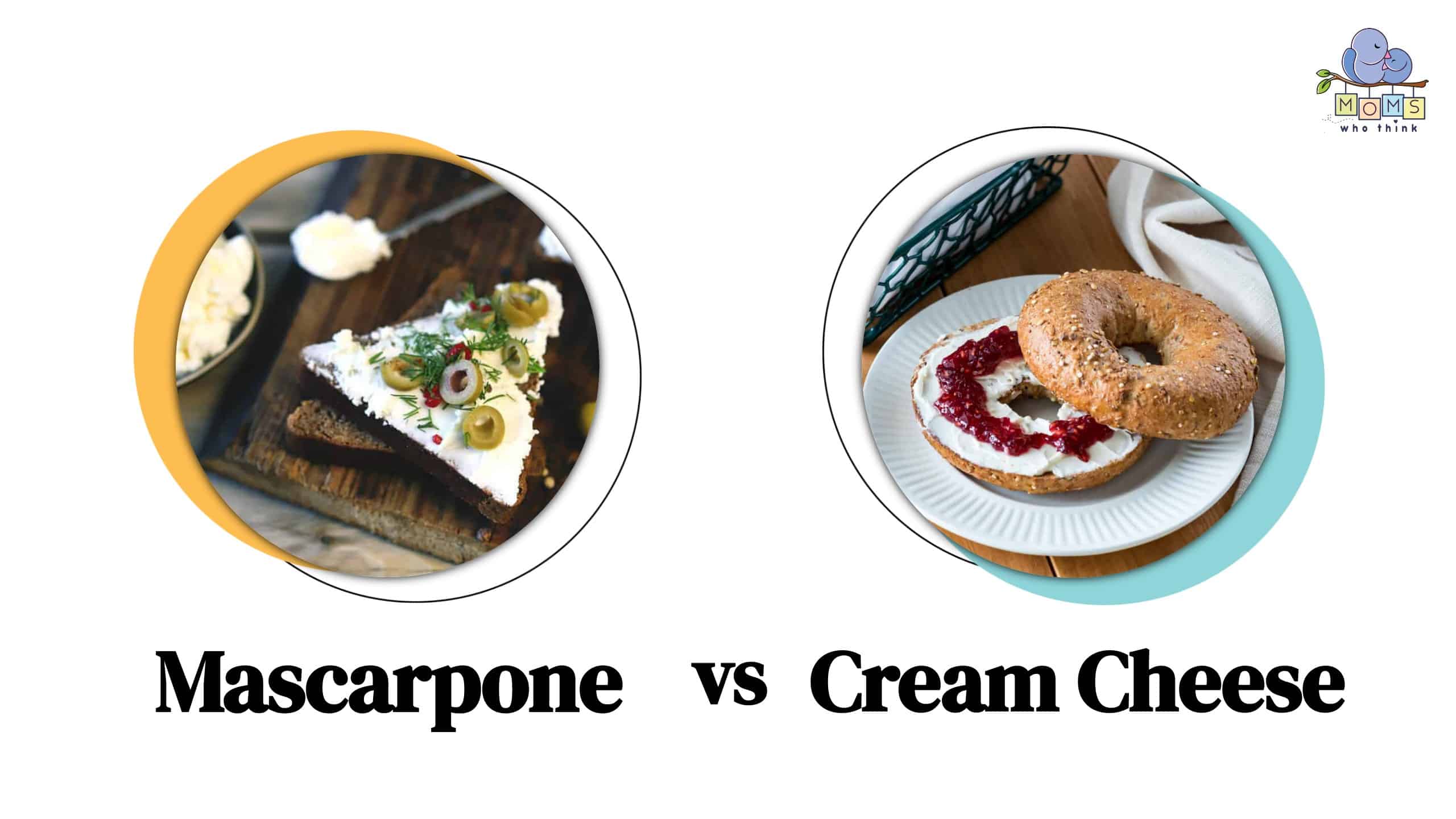Are you looking to make a statement with dessert at your next family meal? If so, you've likely come across two delicious ingredients – mascarpone and cream cheese. While these ingredients may look similar, they differ in flavor, texture, and usage.
In this post, we'll dive into the specific differences between these two popular dairy products. Before you make your next cheesecake or tiramisu recipe, let's take a closer look at mascarpone and cream cheese, so you can create delicious desserts with confidence.
Mascarpone vs. Cream Cheese: What Is the Difference?
The primary difference between mascarpone and cream cheese is their fat content, taste, and origin. Cream cheese is made from cow's milk while mascarpone is made from cream and a coagulant. These ingredient differences lead to cream cheese being more tangy and mild while mascarpone is thicker and richer. In terms of nutrition, cream cheese generally has lower fat content while mascarpone has more calories from fat per serving.
Mascarpone originated in Italy and is widely used in deserts like tiramisu, but also can be used in savory recipes as well. Let's dive into more details that separate these two dairy products.
A Nutritional Comparison of Cream Cheese and Mascarpone: Calories, Fat, Protein, and More
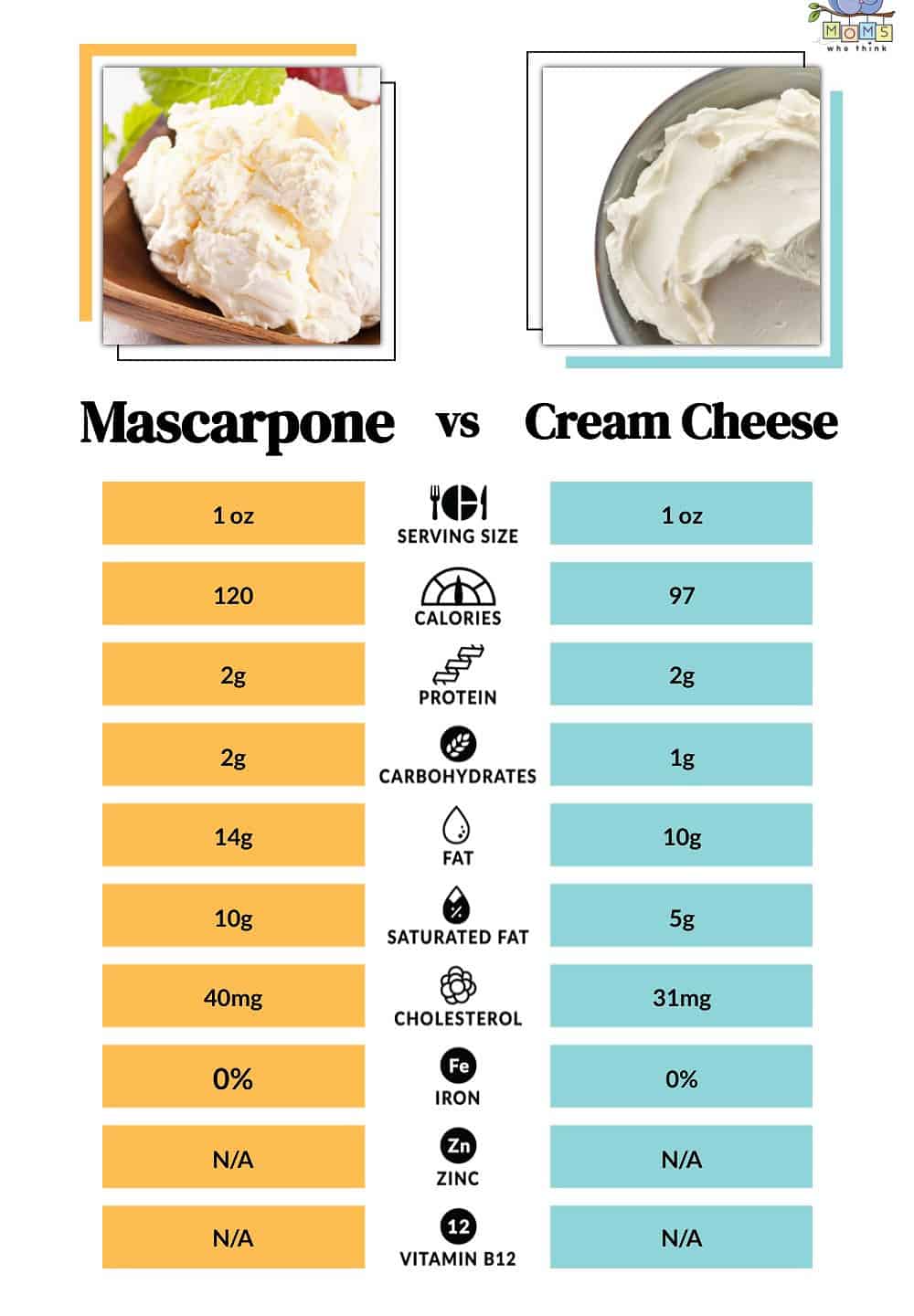
©
Both cream cheese and mascarpone have around 100 calories per ounce, with mascarpone being slightly higher in calories per ounce. The primary difference in their nutritional values is the higher fat and saturated fat content in mascarpone. It's worth noting that different brands of mascarpone and cream cheese can use varying levels of milkfat, which will impact calories. For example, a nonfat cream cheese spread only has about 30 calories per ounce.
What Is Mascarpone?

©Chatham172/Shutterstock.com
As mentioned, mascarpone is a fresh cheese that doesn't require aging. It's often referred to as the Italian version of cream cheese and has a slightly sweet flavor with a high-fat content that leads to its rich flavor and texture.
Origin
Mascarpone is considered the Italian cream cheese because it originated in the Lombardy region of northern Italy. While the exact origins are unclear, the Britannica encyclopedia states that this cheese was likely first produced in the 16th century.
Today, mascarpone is still famously made in Italy. But it's also produced worldwide and can be found at most large grocery stores or specialty cheese shops.
Flavor
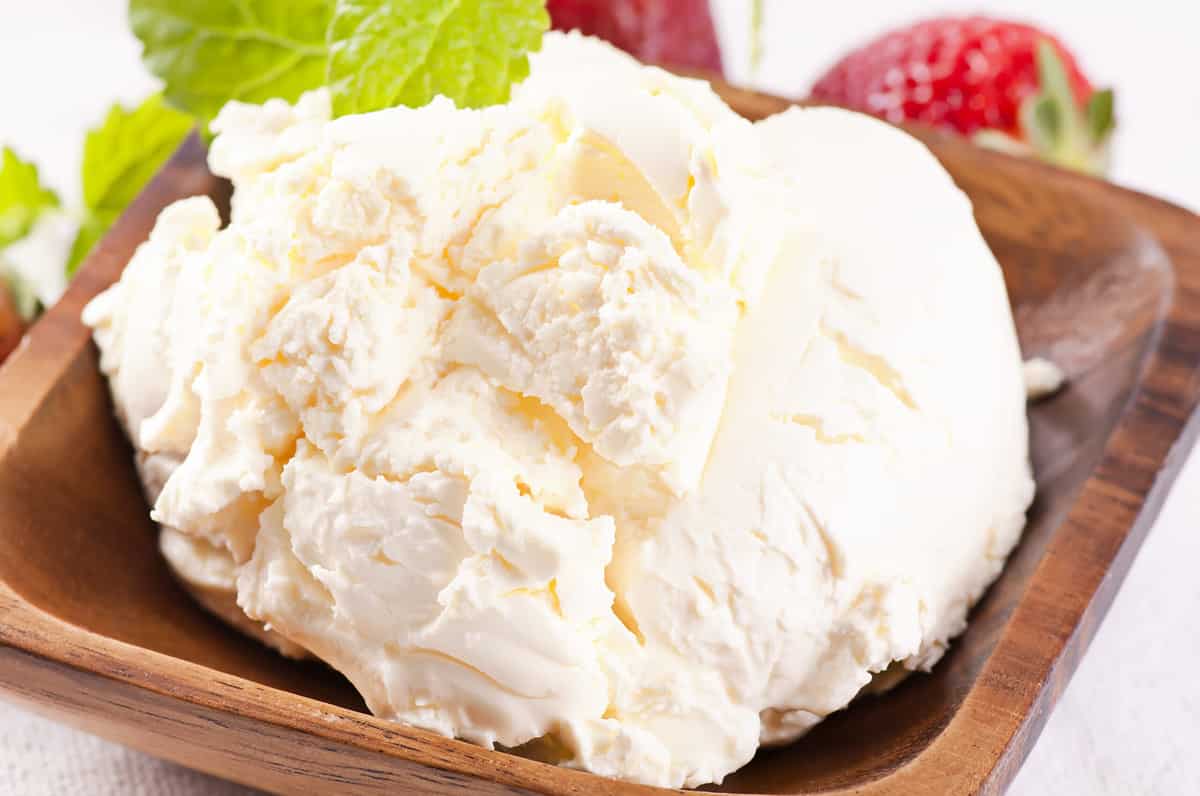
©hlphoto/Shutterstock.com
Mascarpone is known for its rich flavor and slightly sweet, tangy taste. Because it's made from heavy cream that comes from cow's milk, it also tends to have a milky flavor.
Texture and Appearance
Mascarpone cheese is known for its high-fat content, which can range from 60-75%. This can be nearly twice as much as cream cheese, but it's also what gives this ivory-colored sweet cheese its signature velvety texture. Mascarpone is also easy to spread and incredibly smooth.
How Mascarpone Cheese Is Made
Mascarpone has an incredibly easy creation process. It's simply made from heavy cream and an acid. Most commercial producers will use citric acid, but lemon juice can be used if you're making this cheese at home.
After the cream has been heated, acid is added to create curdles. The curdles are then drained from the leftover liquid, also known as the whey, and the resulting cheese is packaged and refrigerated. Because mascarpone is a fresh cheese, it can be eaten on the same day.
Popular Uses
Mascarpone is most traditionally used in Italian desserts like tiramisu, cannoli, and cheesecake. However, because of its versatile, creamy texture, mascarpone can also be used in savory dishes like risotto, pasta sauces, and spreads.
What Is Cream Cheese?

©Toasted Pictures/Shutterstock.com
Similar to mascarpone, cream cheese is a soft, white, fresh cheese that also doesn't require any aging. Cream cheese, though, is lower in fat content and has a tangy, mild flavor.
Origin
Cream cheese originated in the United States in the late 1800s. It's thought that a dairy farmer named William Lawrence first created cream cheese in Chester, New York. In his attempts to add more cream to Neufchâtel, he ended up creating the cream cheese we know today. His creation process eventually turned into the Philadelphia Cream Cheese brand that is now mass-produced.
Flavor
Cream cheese has a mild and slightly tangy flavor that's not as rich as mascarpone due to its lower fat content. Mascarpone has a fat content of 60-75%, while cream cheese is only required to have at least 33%. Cream cheese also tends to be more salty than mascarpone, and its tanginess comes from the lactic acid that's used to produce it.
Texture and Appearance
Cream cheese is an off-white dense cheese that has a thick texture. It tends to be thicker than mascarpone. Cream cheese is also incredibly spreadable, making it an easy choice for spreading on top of bagels, crackers, and other foods.
How Cream Cheese Is Made
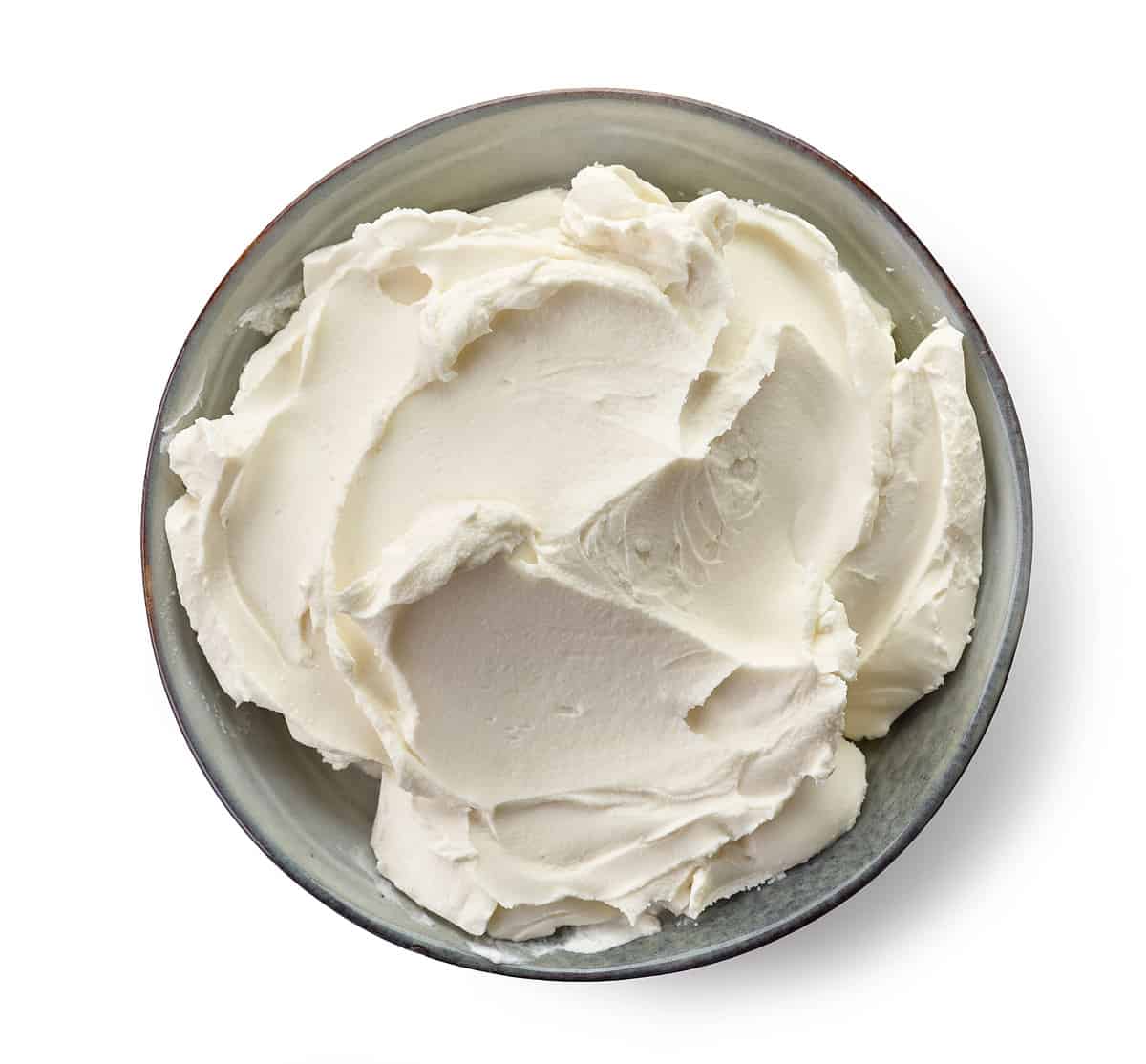
©MaraZe/Shutterstock.com
Like mascarpone, cream cheese's creation process is fairly simple. Instead of full cream, however, milk is mixed with cream, and lactic acid is added to create curdling. The liquid (whey) is then removed from the curds, and the curds are heated and then formed. This cheese is also fresh, so it's ready to eat immediately and doesn't require aging.
It's also possible to make cream cheese at home. Simply add salt and either vinegar or lemon juice to cream or a mixture of cream and milk. When curds form, strain them and puree them in a blender or food processor.
Popular Uses
Like mascarpone, cream cheese is a versatile ingredient that can be used in both sweet and savory recipes. It's most popularly used as a spread for bagels, toast, and crackers, but it can also be used in dips and frosting. Cream cheese is a key ingredient in classic desserts like cheesecake and carrot cake frosting. It can also be sued in pasta sauces, casseroles, and dips.
Are Mascarpone and Cream Cheese the Same Thing?
While these two dairy items may seem similar, they are not the same thing. Mascarpone is rich and velvety with a slightly sweet taste. Cream cheese, on the other hand, is creamy and slightly tangy in flavor.
In a pinch, however, these items may be substituted for each other on a 1:1 ratio. Just keep in mind the flavor differences that can affect your dish from swapping out one for the other.
Another way to make these items perfect substitutes for each other is to slightly modify them before making the swap. If a recipe calls for mascarpone, add heavy cream to cream cheese to give it a higher fat content and similar sweetness and texture. Additionally, if a recipe calls for cream cheese, add a dash of lemon juice to your mascarpone to give it a tangier flavor.
Best Substitutes for Mascarpone and Cream Cheese
In need of a substitute for either of these dairy ingredients? Here are a few other options to try:
- Greek yogurt: Greek yogurt has a thick and creamy texture that can be used as a substitute in some recipes like dips and spreads. It does tend to have a tangier flavor, though, so keep that in mind as this may alter your dish.
- Cottage Cheese: Blending cottage cheese until smooth can create a similar texture to mascarpone or cream cheese. However, like Greek yogurt, cottage cheese has a slightly tangier flavor as well.
- Ricotta cheese: While slightly grainy in texture, ricotta cheese can be used as a substitute in recipes like cheesecake or lasagna.
- Neufchâtel cheese: This soft, French cheese is similar to cream cheese and works well as a substitute. However, it's higher in moisture so it works better as a substitute in dips and spreads as opposed to desserts and other baked goods.
Mascarpone Recipes
Cream Cheese Recipes
Print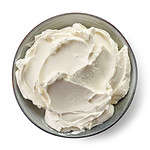
Pumpkin Cream Cheese Dessert
Ingredients
- ½ cup butter
- ⅓ cup white sugar
- 18 whole graham crackers (2 packages), crushed
- 2 eggs
- ¾ cup white sugar
- 1 (8 ounce) package cream cheese, softened
- 1 envelope (1 Tablespoon) unflavored gelatine
- ¼ cup water
- 1 (15 ounce) can pumpkin
- 3 eggs, separated
- ½ cup milk
- ½ cup white sugar
- ½ teaspoon salt
- 2 teaspoons ground cinnamon
- ½ pint whipped cream
Instructions
- Preheat oven to 350°F (175°C). Lightly grease a 9×13 inch baking dish.
- In a medium saucepan over medium heat, melt butter. Stir in the sugar and mix well. Stir in graham cracker crumbs. Pat the mixture into baking dish.
- In a medium mixing bowl, beat together the egg yolks, sugar and cream cheese. Pour the mixture over crust.
- Bake 20 minutes in the preheated oven. Remove from heat and allow the mixture to cool. In a small bowl, dissolve the gelatine in water.
- In a medium saucepan over medium heat, mix the pumpkin, eggs, milk, sugar, salt and cinnamon. Reserve the egg whites.
- Stirring constantly, cook until thick, about 4 minutes. Remove from heat and mix in the gelatine. Allow the mixture to cool for approximately 20 minutes.
- In a small bowl, beat the 3 egg whites until stiff. Gently fold the egg whites into the cooled pumpkin mixture.
- Pour the pumpkin mixture over the cream cheese mixture. Top with whipped cream. Cover and refrigerate approximately 2 hours.
Final Thoughts
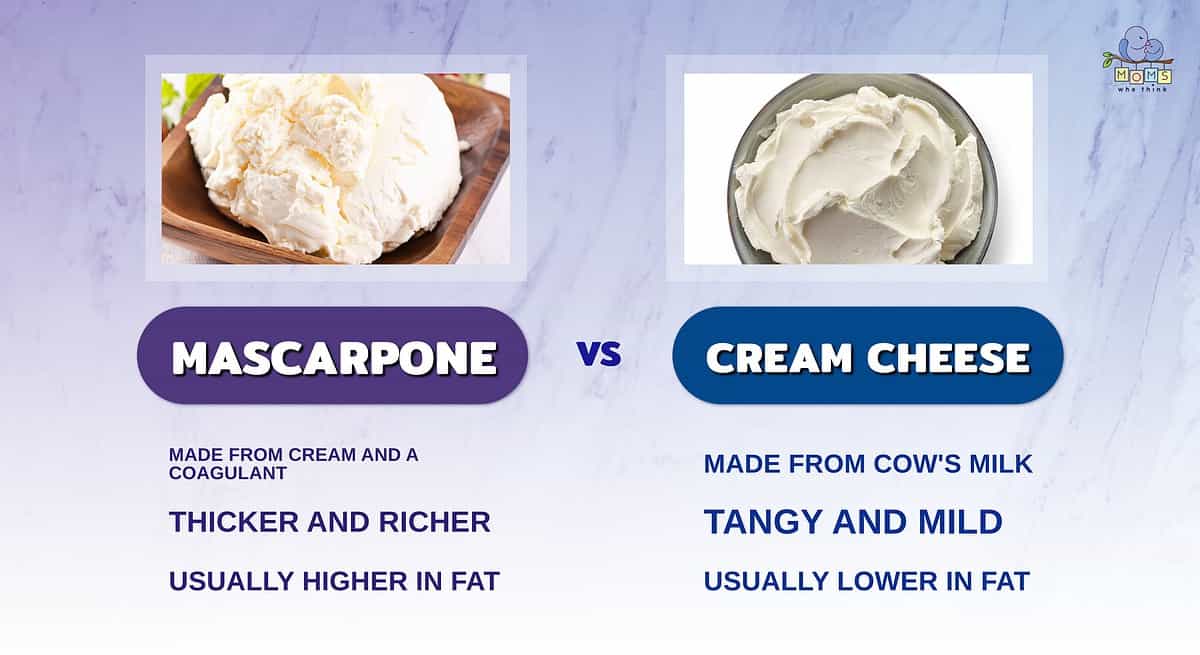
- Mascarpone is made from cream and a coagulant, while cream cheese is made from just cow's milk.
- Cream cheese has a tangy and milder taste compared to mascarpone. Many people enjoy it as an ingredient in some desserts, or spread over bagels.
- Mascarpone is usually higher in fat, making cream cheese the better choice for those watching their diet.
In conclusion, if you're looking to up-level the dessert at your next family meal, mascarpone and cream cheese are two versatile and delicious ingredients that you can include in your recipe. While these two dairy products look similar, they differ in taste and texture.
Whether you're making a classic tiramisu or a creamy cheesecake, you now have a better understanding of the unique qualities of mascarpone and cream cheese, so you can create delectable desserts with confidence.
